|
 Hygrophorus salmonipes Hygrophorus salmonipes
BiostatusPresent in region - Indigenous. Endemic
Images (click to enlarge)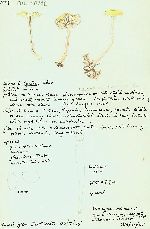
Owner: G.M. Taylor | 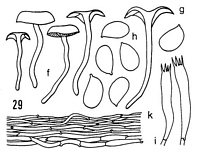
Caption: Hygrophorus salmonipes Stev.: f. carpophores. - g. spores (type). - h. spores. - i. basidia. - k. cuticle | 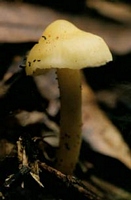
Caption: Hygrophorus salmonipes
Owner: Kaimai Bush | 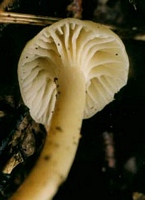
Caption: Hygrophorus salmonipes
Owner: Kaimai Bush | 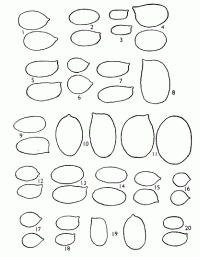
Caption: Spores X 2000 1. Hygrophorus salmonipes 2; H. elsae; 3, H .julietae; 4, H. variabilis; 5, H. lilaceo-lamelllatus; 6, H. muritaiensis; 7, H. keithgeorgei; 8, H. pseudococcineus; 9, H. rubro-carnosus; 10, H. miniceps; 11, H. procerus; 12, H. multic | 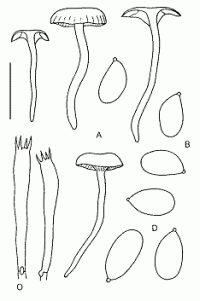
Caption: Fig. 41 Hygrophorus salmonipes Stev. (A-C: ZT 68/549): A. basidiomes.
B. spores. C, basidia. (K 606, type): D. spores. | 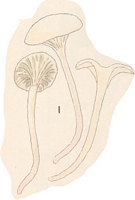 | 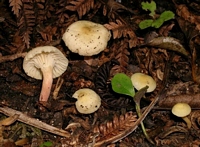
Caption: FUNNZ photo
Owner: J.A. Cooper | 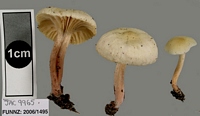
Caption: FUNNZ photo
Owner: J.A. Cooper | 
Caption: basidia
Owner: J.A. Cooper | 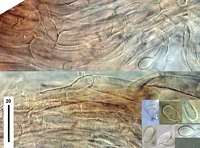
Caption: cap hyphae and spores
Owner: J.A. Cooper | 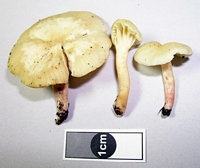
Owner: J.A. Cooper | 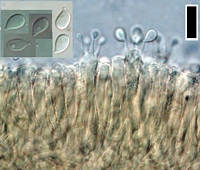
Caption: scale=10um. Gill edge and spores
Owner: J.A. Cooper | 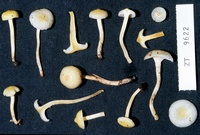
Caption: ZT9622
Owner: E. Horak: © Creative Commons Attribution-Noncommercial 3.0 New Zealand |
Article: Horak, E. (1990). Monograph of the New Zealand Hygrophoraceae (Agaricales). New Zealand Journal of Botany 28(3): 255-306 (http://www.rsnz.org/publish/abstracts.php).
Description: Pileus -25 mm, hemispherical becoming convex to plane with umbilicate centre;
pale yellow-green, fading to whitish or creamy; viscid when moist, hygrophanous,
distinctly striate at margin. -Lamellae deeply decurrent, arcuate; whitish to
pale green, fading to pale argillaceous (brown in dried specimens), edges concolorous,
entire. - Stipe 3050 x 1-2 mm, cylindrical, equal or tapering towards base,
concolorous with pileus above, orange at base; dry, glabrous, fragile, solid.
- Context whitish, pink or orange in base of stipe. - Odour and taste not distinctive.
- Chemical reactions on pileus: unknown.
Spores 7-10 x 4.5-5.5um, ellipsoid to comma-shaped. - Basidia 35-45 x 6 um,
4-spored. - Cystidia absent. - Pileipellis an ixocutis of cylindrical, repent
or interwoven, hyaline hyphae (2-6 um diam.), membrane gelatinised, with plasmatic
pigment; clamp connections present (Pl. 1, Fig. 7).
Habitat: ECOLOGY: Scattered; saprobic on soil among litter in mixed broadleaved forests
(Weinmannia, Knightia, Cyathea). May-June.
Distribution: DISTRIBUTION: NZ (T, W).
Notes: The preferred habitat of H. salmonipes (Stev.) is the anectotrophic
broadleaved forests of North Island. In nature this species resembles H.
involutus (Stev.) but is macroscopically separated by the greenish tinge
on pileus-stipe and the conspicuously orange coloured base of the stipe (cf.
H. segregatus Horak). In addition the two similar taxa are distinguished
by the size and shape of the spores.
Article: Stevenson, G. (1963) [1962]. The Agaricales of New Zealand: IV. Kew Bulletin 16(3): 373–384.
Description: Pileus 2-2.5 cm. diam., creamy,
hemispherical, with or without a broad shallow umbilicus; flesh thin, creamy.
Gills deeply decurrent, cream, triangular in section with a rather thin edge,
occasionally forking. Stipe 4-5 cm. X 2-4 mm., creamy above, pink below, solid,
rather fragile, tapered towards base. Spores 6 x 10 µm. ovoid, thin-walled.
Basidia 45-60 X 7 µm, four-spored.
Habitat: habitat:
amongst litter, Keith George Park, Wellington, 30.5.19491
Stevenson.
Article: Horak, E. (1973). Fungi Agaricini Novazelandiae I-V. Beihefte zur Nova Hedwigia 43: 200 p.
Description: Pileus 15-25 mm diam., hemispherical later becoming convex, aged specimens with shallow umbilicus, yellowish-greenish, fading to whitish-creamy, hygrophanous, distinctly striated at the margin, dry. Lamellae deeply decurrent, arcuate, whitish-greenish, fading to cream, brownish on dried carpophores, gill edge concolorous. Stipe 30-50 x 2-4 mm, cylindrical, equal or tapering towards the base, glabrous, dry, fragile. Context whitish. Taste and odor not distinctive. Chemical reactions on pileus unknown.
Spores 7-9 x 4.5-5 µm, ellipsoid to subvirguliform, smooth, inamyloid. Basidia 35-40 x 6 µm, 4-spored. Cystidia absent. Cuticle a cutis of repent, hyaline, cylindric, not gelatinized hyphae (2-6 µm diam.). Clamp connections numerous.
Habitat: In soil under Weinmannia, Knightia, Cyathea, etc. New Zealand.
Notes: Macroscopically aged fruiting bodies of H. salmonipes Stev. could resemble H. involutus Stev. but the spores of the latter species are smaller and the structure of the cuticle observed in the two fungi is quite different.
|